Pkg Solutions
Quality Glossary
Preparation Of Corrugating
Adhesives
he Corrugating Adhesive
Three general requirements of an adhesive are (1) it must wet the two surfaces
to be bonded, (2) it must be film- forming and (3) it must be of suitable
"thickness" or viscosity. A desired property is viscosity stability
or resistance to breakdown during circulation and application.
Early Adhesives
It is instructive to look at the history of corrugating adhesives to see
how well various types have met these requirements. The very first corrugating
adhesive was a cooked paste of flour and water. In order for a
completely cooked paste of this sort to be low enough in viscosity to
be handled on a corrugating machine it could not exceed a solids content
of about 6%. At that solids content, which means that the paste would
contain about 6 pounds (2.7 kg) of flour for every 94 pounds (42.6 kg)
of water, the rate at which a film could form was very slow. It took a
long time for the 94 pounds (42.6 kg) of water to be absorbed by the paper
or evaporate sufficiently for the viscosity to become high enough for
the adhesive to tear paper. This was an adhesive with a very slow setting
speed and, as a consequence, the corrugator could not run at speeds greater
than about 15 or 25 feet (4.6 or 7.6 meters) per minute.
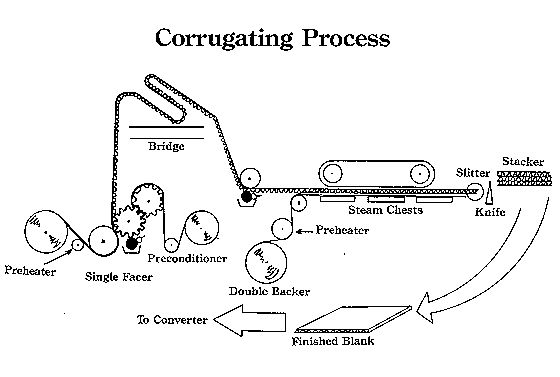
The next generally accepted adhesive for the corrugating
industry was one based on sodium silicate or silicate of soda.
Silicate Is a highly alkaline,
inorganic, colorless, adhesive made by fusing silica sand with soda ash.
Such an adhesive had a low viscosity even though relatively high in solids
content - about 25%. Its high alkalinity helped to wet paper surfaces
which frequently contain rosin size to help make the paper more water-repellent.
In addition, silicate solutions have the property of suddenly undergoing
a very enormous increase in viscosity after they lose a relatively small
amount of water. Because the silicate could be
applied at a high solids and because it increased in viscosity so rapidly
after the loss of a small amount of water, it rapidly replaced the cooked
flour paste and permitted the attainment of much higher production speeds.
The major disadvantage of sodium silicate in relation to the adhesive
properties we outlined earlier is its poor film forming ability. Additionally,
on aging, or in the presence of excessive heat, silicate will tend to
change from a wet film to a crystalline solid. In this crystalline state,
the ability to maintain the bond between the two pieces of paper is diminished
and the adhesive becomes powdery and discontinuous.
Although silicate of soda was superior to flour pastes, it still left much
to be desired and the starch industry continued its attempts to replace
silicate. By making a suspension of uncooked starch in water, the viscosity
can be kept at very low levels which are suitable for distribution to
and application on the corrugating machine. The solids of this type adhesive
can be regulated at anywhere from 15 to 35% solids, with a level of about
18-25% most common for domestic board and 25-30% for water-resistant board.
Upon the application of heat, the suspended starch particles
absorb water and swell producing a very high viscosity which will
continue to increase at a rapid rate as small amounts of water are lost
into the board and the surrounding atmosphere. Basically, that's all there
is to a starch corrugating adhesive-starch suspended in water. However,
there are a number of additives, each of which serves a very important
function and without which the use of starch as a combining adhesive would
be impractical, if not impossible.
NOTE: The starch referred to in this booklet is corn starch. Other starches,
heavily influenced by geography, such as wheat, potato, and tapioca may
be utilized in various situations.
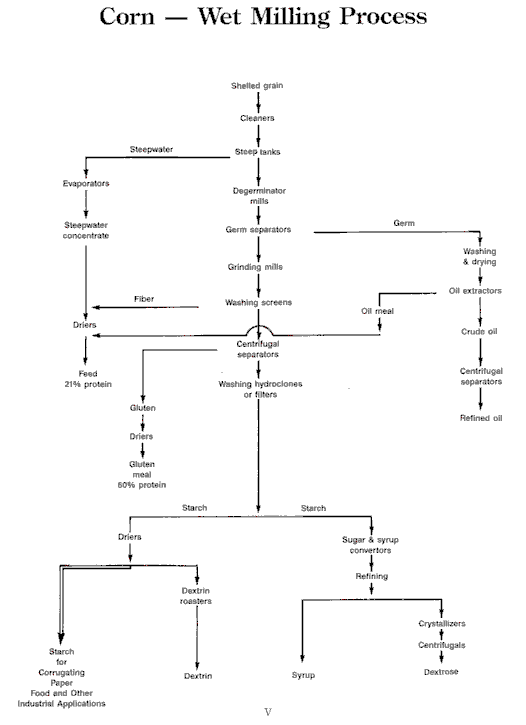
Starch
Granules and Molecules
Commercial powdered starches actually are tiny granules, smaller than sand.
These granules are made up of two types of molecules. One type is Amylose
(straight like a pencil) and Amylopectin (branched chains like tree branches).
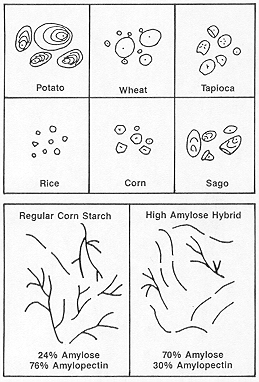 |
The following
Table shows the amylose content of several starches. Because of their
pencil-like shapes the amylose molecules are able to attach to themselves
and penetrate paper more easily. This allows a higher rate of film forming
and green bond forming. This leads to faster running speeds on the corrugator.
Amylose Content of Starches
| Source |
% Amylose |
| Maize (Corn) |
24 |
| High Amylose Maize |
50 |
| High Amylose Maize |
70 |
| Waxy Maize |
0-3 |
| Potato |
20 |
| Tapioca |
17 |
| Wheat |
25 |
|
Without a high rate
of agitation, starch granules will settle out in bends and low spots in
pipes, glue pans, pumps, and any other place where the suspension is not
kept moving sufficiently to prevent the particles from settling. It is
not unusual for settled starch granules (when wet) to cause agitator blades,
pump parts, etc. to break when an attempt is made to redisperse this settled
raw starch. Addition of cooked starch to the slurry however, virtually
prevents the starch granules from settling even in the absence of agitation.
Coupled with the suspension of the granules, the carrier also imparts
viscosity to the slurry and thereby regulates the amount of
adhesive applied when the rolls are at a given setting. The carrier
also regulates the rate at which water is lost from the slurry into the
medium and liner in the interval between application of the adhesive and
the development of a high enough temperature to begin the swelling of
the starch granules.
Notice that, so far, when we've talked about starch adhesives we referred
to two different levels of viscosity. The low viscosity range is anything
that's capable of being measured in the Stein-Hall cup - from 15 seconds
up to perhaps 200 seconds. The high viscosity which occurs at the flute
tips when the raw starch granules gelatinize is so high that it is virtually
unmeasurable by conventional means. If you pour a little starch adhesive
on a preheater you will observe that it very rapidly turns into a rubbery
substance. As this dries and continues to increase in viscosity, it increases
in strength until such time as it is strong enough to tear paper if an
attempt is made to separate the two components.
Major Corrugating Adhesive Components
Water - heated and for cooling/dilution
Carrier Starch - cooked
Raw or Slurry Starch
Caustic Soda
Borax
Preservative
Additive for Water Resistance
Others - Wetting Agents, Urea
- Defoamers
- Colorants
Carrier and Slurry Starches
Usually about 1/5 of the total starch is precooked with caustic soda and
added to the slurry or suspension of starch granules in water; this cooked
portion of the adhesive is called the carrier. Because of the influence
of the cooked carrier portion, many feel it is the "true" adhesive.
The name carrier relates to its function as a suspending agent for the
raw starch granules. Starch granules will very rapidly settle out of water
unless they're kept rather well agitated. Settled starch tends to compact
and form a semisolid mass which is very difficult to redisperse. It possesses
a property which we have labeled "dilatancy" and which is encountered
in nature in the form of quicksand.
Water
Water is important, for a number of reasons. It is the vehicle without
which nothing happens. Moisture levels in the adhesive and paper greatly
influence the adhesive and ultimately the bonds.
· Allows Carrier Starch to Cook
· Reduces Carrier Temperature
· Dilutes Carrier to permit Raw Starch addition
· Allows raw starch to swell and gel
· Assists in Viscosity Control
NOTE: See Appendix "Water Added to Corrugated Board from Corrugating
Adhesives!'
As shown in the following chart, wet tack increases with specialty carriers
containing different arnylose levels and chemical treatments.
|
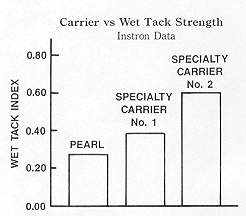 |
Starch
Carrier Starch
· Suspends Raw Starch
· Imparts Viscosity
· Holds water for Raw Starch
· Controls water absorption into medium
· Wet Tack
· Affects Corrugator Speed
· "True Adhesive"
Raw Starch
· Absorbs water to form green bond
· When gelatinized becomes part of adhesive |
Caustic Soda
Caustic Soda, which is added to most corrugating formulations plays quite
a number of roles simultaneously. If we slowly add a solution of caustic
soda to a starch slurry, eventually we'll reach a point at which the starch
will swell or "cook". This will occur even if the starch is
at room temperature. Corn starch cooked with caustic soda is more stringy
and cohesive than corn starch cooked merely by raising the temperature
of a starch in water slurry. Without it, the cooked starch would be short
and pasty.
Caustic
· Helps to cook the Starch
· Gives Starch a stringy, sticky texture
· Provides Bite into paper
· Controls Gel Point
· With Borax - raises Viscosity and Tack
If we add carefully controlled amounts of caustic soda to a starch slurry,
we can reduce the amount of heat that is needed to make that starch swell.
Unmodified corn starch which normally swells at about 165'F (74'C) in
water, can be made to swell at temperatures as low as 1.38'F (59'C) if
caustic soda is added. If we attempt to add more caustic soda and get
the gelatinization temperature down to, let's say 130'F (54'C), so that
the machine can be run faster, we'll find that the starch will gradually
swell even at room temperature. The lowest practical gelatinization temperature,
therefore, to which corn starch can be adjusted with caustic soda for
corrugating formulations is about 138'F (59'C). If enough caustic soda
is added to produce a 1.35`F (57Q gelatinization temperature, the likelihood
is very strong that the starch will thicken prematurely and the adhesive
would be applied at heavier than desired levels or ultimately become too
viscous to pump through the existing lines and pans. At gelatinization
temperatures about 1.38'F (59'C) the slurry suspension will remain low
in viscosity and will experience a very sharp gelatinization temperature
on the application of heat.
The presence of caustic soda lowers the gelatinization temperature of the
starch but also has several important side effects. In the presence of
caustic soda, the paper is more effectively wetted by water or starch
dispersions than it is when caustic soda is not present. The caustic soda
attacks the rosin size usually present in linerboard and gives the adhesive
better "bite" into the paper. It also has a slight softening
or swelling effect on the cellulose in the paper fibres, thus increasing
the specific adhesion of the starch to the cellulose.
The presence of caustic soda raises the p11 of the adhesive which renders
the adhesive formulation non corrosive to iron and steel, removing the
necessity for stainless steel lines, tanks and glue pans.
Borax and Boric Acid
Another common ingredient of corrugating adhesives is borax. It is mined
from the ground in several varieties, 5 mole and 10 mole. The moles refer
to the amount of water present. Boric acid, another type, requires the
addition of extra amounts of caustic soda.
Since the 5 mole version of borax contains less water than 10 mole, different
amounts are required to obtain the same tack and viscosity in the final
adhesive.
Example: 24 lb (10.9 kg) of 5 mole = 32 lb (14.5 kg) of 10 mole
A handy conversion factor is 1.33 (4/3) if changing to 10 mole in place
of 5 mole. Or, conversely, if changing from 10 mole to 5 mole, multiply
the pounds of 10 mole by 0.75 (34).
Borax
Imparts Viscosity Adhesive becomes, gummy, cohesive. and highly tacky Affects
Gel Point
The borax reacts with the caustic soda to yield sodium meta borate. This
consumes a small portion of the caustic [about 0.2 lb per lb (0.2 kg/kg)
of 10 mole borax]. Thus the addition or removal of borax affects gel temperature
as well as viscosity and tack. A large excess of borax is not good. It
can help cause brittle bonds and reduce water resistance.
Borax and Reaction with Caustic Soda

If we add borax to a
6% starch solution, the viscosity will increase by two, three or four
fold, depending on the amount of borax added up to about 10 or 15% borax
by weight on the starch. The addition of the borax converts the starch
from an opaque to a clear suspension, much higher in viscosity than the
original sample and, rather than being pasty, mayonnaise type material,
the starch solution has now become gummy,
cohesive and highly tacky. It now has properties not
unlike those encountered in rubber cement. To compound the story, if an
equal amount of caustic soda is added to this starch-borax combination,
the viscosity and tack will double that which was achieved by addition
of the borax alone. Caustic soda by itself, while it will change the starch
from opaque to clear and make it cohesive and fluid rather than pasty,
does not have the effect on viscosity and tack that is obtained from the
borax.
By careful adjustment of the concentration of caustic soda and borax in
the adhesive formulation, the starch service person can provide a formulation
with the desired gelatinization temperature, with high tack to hold the
board together at high speeds while awaiting the development of a starch
film with good final adhesion and noncrystalline properties.
Boric Acid
The other member of the borax family, Boric Acid, is stronger than borax.
Only 21 pounds (9.5 kg) are equivalent to 24 pounds (10.9 kg) of 5 mole
or 32 pounds (14. kg) of 10 mole borax. However, it is acidic and
will neutralize more of the caustic soda than either 5 or 10 mole borax
A conversion chart is included in the Appendix.
Preservatives
The last common material added to corrugating formulations is the preservative.
Formaldehyde or other equivalent materials such as sodium pentachlorophenol
or sodium orthophenylphenate is normally added to domestic batches. It
is important to add preservative to prevent organisms from attacking the
starch based adhesive formulations, particularly the carrier portion.
A carrier starch is usually only present at about a 5 or 6% starch solution
and is very susceptible to attack by bacteria even at the very high alkalinity
which exists in corrugating formulas. Particularly disconcerting is the
fact that these bacteria can attack the carrier starch before causing
any objectionable odor or otherwise making their presence obvious. The
result is an extremely rapid loss in viscosity, poor water holdout
on the flutes and some tendency for the ~ranular starch to settle. This
problem can easily and inexpensively be circumvented by adding preservative
to each 700 gallon (2,650 litres) batch of corrugating adhesive. Additional
preservatives should be added if adhesive is stored over the weekend.
NOTE: 1 - See Cleaning Procedure in Appendix.
2 - "Other Reading" - No. 3 in Appendix.
Water
Resistance Additives
The adhesive is rendered moisture resistant or water- resistant
by the addition of materials such as ketone aldehydes. These materials
cross-link the starch molecules making it more difficult for water to
dissolve the starch. The WRA should be used up within 6-24 hours after
the cross- linking agent is added to the adhesive (follow manufacturer's
recommendations).
It is also normally desirable to increase the starch solids in water-resistant
formulations and apply at higher viscosities and application levels than
domestic adhesives.
To achieve the highest possible level of water resistance from your formulation,
it is usually helpful to allow time in the stacks for the cross-linking
step to continue. A moist, warm glue line with sufficient starch application
and time in the stack (usually 12-24 hours) should enhance water resistance.
Other Additives
Defoamers
The presence of excessive amounts of foam in the adhesive can lead to problems,
such as overflowing of adhesive from pans, affect application, etc. Some
of the causes of foam are the pumps, adhesive applicator roll surfaces,
pan configuration, contamination, etc.
Sometimes the addition of a small amount of defoamer such as corn oil causes
the bubbles to break up more easily which usually eliminates the foam.
Your starch supplier can suggest other additives or approaches if the
problem persists.
Colorants
Occasionally it is useful to "color" the WRA to help ensure that
the changeover from the domestic adhesive has been completed at the machine.
The addition of a very small amount of a FDA approved pigment usually
suffices.
Wetting Agents
Additives are occasionally added to the adhesive with the purpose of increasing
the rate of wettability of the medium or liner. Improvement in wettability
has occasionally been noted by this practice. However, caution
must be exercised because when the shipment of "hard to wet"
paper has been used, the wetting agent may still be in the adhesive. The
next lot of paper may be relatively easy to wet. This might allow the
water in the adhesive to literally rush into the medium leaving insufficient
water to gelatinize all of the raw starch. This would result in a white
glue line and possibly brittle bonds, loose back, etc.
Urea
Another additive, urea, has been noted to improve bonds, particularly at
the single facer. The urea appears to help hold moisture at the glue line.
The amount usually added is about 20-30 pounds per 700 gallon batch (944
kg/2600 1. batch).
Gel Temperature
To shorten the time from starch application to its reaching
the temperature of gelatinization, the gel point of the starch is lowered
by adding more caustic soda in the formula. A gel temperature of 140-142
degrees F (60-6PC) at the D13, and for Fingerless Single facer is considered
suitable for increasing the bonding rate of the starch, enabling faster
machine speeds. For the conventional SF, a gel temperature of 146- 152'F
(63-67Q is usually desirable. The double facer is usually adjusted for
heavier viscosities of 35 to 50 seconds and slightly higher solids. This
has improved the transfer to liners, resulting in a better adhesive pattern
and stronger bond. With the gravure roll, a "printing" rather
than just a "wiping on" of the adhesive occurs at the double
facer glue station.
Preparation
Methods
Corrugating starch adhesives may be prepared in practically any mixing
equipment. Both manual and automatic systems are made by the Ringwood
(Henry Pratt) Company, the Adhesives Mixing Equipment Co. (Sherman), and
others. In the One Tank Method, the
adhesive is prepared entirely in the Secondary ("Bottom") Mixer.
The Two Tank Method utilizes both the Primary and Secondary Mixers of
this system. Both procedures illustrated in the table below utilize pearl
corn starch in domestic formulas.
*Multiply by 1.33 if using 10 mol borax.
- NOTE: There are many
variations of these formulations depending on the condition of equipment,
type of equipment, degree of automation of mixing equipment, corrugating
capability, and product mix.
|
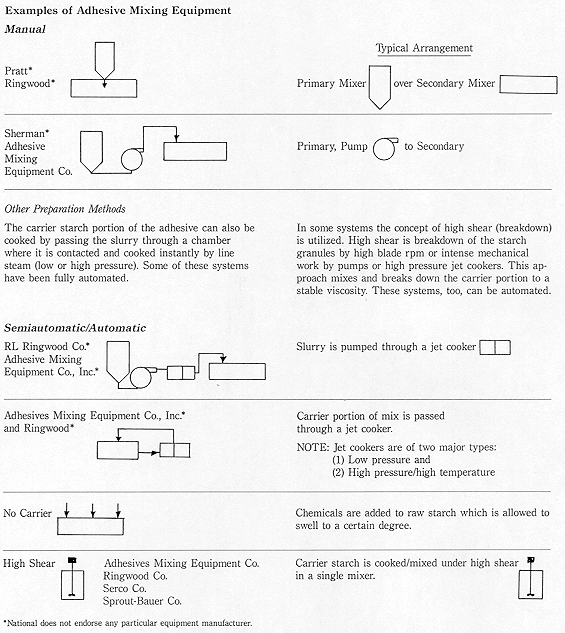
|
666 (2520 L) Bottom (Secondary) Mixer Guidelines
5 or 7.5 HP* motors are generally being replaced by 10 or 15 HP size -
with the speed reduced to give a shaft speed of about 450-550 rpm.
Mixers have either 4 or, preferably, 6 propellers
Propellers have 10' pitch and are 15 inches (38 cm.) in diameter.
Best circulation is usually from middle of mixer toward end.
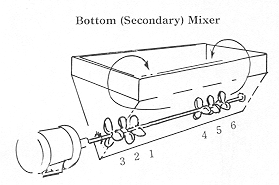
- NOTE: As the shaft spins, propellers 1, 2 and 3, push to left end and
propellers 4, 5 and 6 push to the right end. The mechanic has
to be advised of this when remounting the propellers on the shaft. If
the propellers are mounted exactly in reverse, the motor leads can be
reversed to get the preferred direction.
*1 HP = 746 watts
5 HP = 3.73 kilowatts
7.5 HP = 5.6 kW
10.0 HP = 7.46 kW
15.0 HP = 11.2 kW |
Application
of Adhesives
Mechanism
Involved in the Formation of the Adhesive Bond on the Corrugator
All of us are familiar with the typical starch based corrugating adhesive
as it is used in the typical box plant. Most of us are familiar with it
in its final dry form as it bonds the corrugated paper components. However,
few understand the complex sequence of events through which the corrugating
adhesive must pass as it is transformed from the liquid state of its application
to the final dry solid state.
The process itself consists of the following sequence that must occur in
this order in the presence of adequate heat.
Ideal Sequence of Events
1. Application - transfer from glue roll to flute tip
2. Pre-adhesion Dynamics
a. wetting of the paper surface by the adhesive -
water and caustic soda soften the paper fibres or
"bite into them"
b. diffusion or penetration - the liquid adhesive is
absorbed or strikes into the paper (note: water
moves in very rapidly taking dissolved materials,
especially carrier starch with it)
c. adsorption or specific adhesion - the starch is
strongly attracted to the cellulose of the paper
3. Raw Starch Gelatinization
- the raw starch of the corrugating adhesive begins gelatinization
causing a rapid viscosity increase in the adhesive.
4. Green Bond or Initial Bond
Formation
5. Drying of the Adhesive - the heat present in the
corrugating process evaporates the water from the adhesive. A large portion
of the water diffuses from the adhesive into the paper components and
is actually evaporated from the paper.
The pre-adhesion dynamics represent a very critical stage in the dynamic
process of the corrugated bond formation. Since these events occur first
at the flute tip of the corrugated medium, which by its nature is highly
absorbent, one would expect that a significant proportion of the water
in the adhesive would be lost or separated from the starch solids of the
adhesive. This diffused water also brings a portion of the cooked carrier
starch with it so that the proportion of raw starch to carrier at the
flute tip is greater than it was in the adhesive at the moment of application.
This separation of the water and carrier components lowers the overall
efficiency of the adhesive.
1. Water loss - the ungelatinized starch granule has the capacity to absorb
about 20 times its own weight of water and expand to about 100
times its original volume. The relatively high solids of the corrugating
adhesive raw starch, therefore, allows only a partial swelling of the
raw starch granules. The identity of these granules exists In the final
dried glue line and their ability to form the continuous film required
of the adhesive is at best limited.
2. Carrier loss - the carrier starch is the true adhesive because it
is "dissolved" and capable of forming a continuous film. The
carrier starch is analogous to the Portland Cement that binds the aggregate
(the raw starch) in concrete. To the extent that carrier is lost in the
paper, the proportion of aggregate to cement increases and the quality
of the "concrete" is reduced.
|
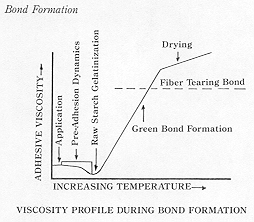
|
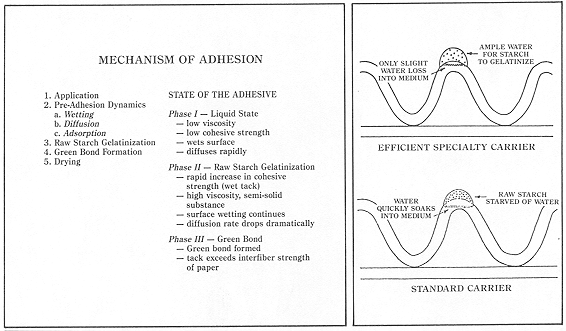 ") ")
|
Specialty
Carriers are much more efficient carriers than is unmodified
corn starch because of the following properties. They can be formulated
in any equipment.
1. Water holding - substantially better than corn starch, allows more complete
swelling of raw starch.
2. Rapid viscosity increase - the amylose fraction causes a rapid
viscosity increase with only a small loss of water (increase in carrier
solids).
3. Rapid wet tack buildup - the increase in wet tack or wet film strength
is much more rapid with specialty products than with pearl corn starch.
This means faster penetration and development of green bond and more
speed.
4. Adhesive efficiency, low application
levels Specialty Carriers are more efficient than pearl corn starch so
smaller liquid volumes of adhesive can be used to effect the bond. This
helps make flatter board.
5. The properties of Specialty Carriers, especially the added tack and
penetration helps overcome variations in paper.
Competing Events - The Great Race
The corrugating bonding process is a highly dynamic one that is occurring
on very hot moist medium that is an ideal absorbent. After adhesive application,
wetting, diffusion, and adsorption to the cellulose fibre, raw starch
gelatinization must occur very rapidly or the
"Great Race" may be lost. The competing events of 1) water loss,
2) carrier loss and the resulting 3) adhesive component separation discussed
above also occur very rapidly. If they have progressed to too large an
extent, the bond will at best be marginal and the glue line will show
white, ungelatinized starch.
On the other hand, if gelatinization of the raw starch takes place too
rapidly, insufficient wetting and adhesive penetration will occur. This
ultimately yields a dry crystalline surface bond and the "popcorn"
board with which, unfortunately, we are all familiar.
Multiple Sequence
The sequence of application, wetting, diffusion, and adsorption actually
occurs twice at every glue line. It first occurs on the flute tips of
the medium, as we've discussed above, but it also occurs again when the
adhesive at the flute tip comes in contact with the liner which is to
be bonded. The adhesive has the ability to wet the liner and form an adhesive
bond even if the raw starch portion is completely gelatinized, provided
a significant amount of drying of the adhesive has not occurred.
Very dry corrugated medium or liners can present a significant problem
due to premature drying of the adhesive. Excessively wet components, on
the other hand, also cause major difficulties by maintaining a high moisture
level in the adhesive and allowing diffusion and penetration of the adhesive
into the components to continue.
Preconditioning of Medium
It is usually helpful to precondition the medium as
follows:
1. Apply heat by using preconditioner
2. Apply steam at preconditioner
To:
1. Make paper more receptive to the adhesive by opening the pores of the
paper
2. Soften medium to assist in flute formation
|
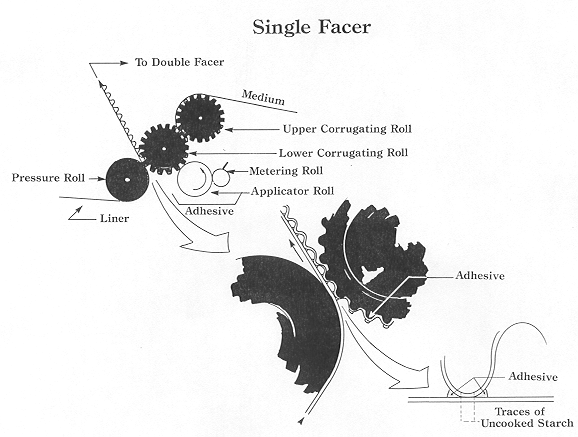 |
Single facer
There are enormous differences in the time allowed for the bond formation
process described above to take place at the single facer and the double
backer. At the single facer flutes are being formed and bonded at rates
approaching 600 per second with high temperatures and high pressures.
At normal operating speeds, as the web emerges from the single facer at
best a tenuous "green bond" usually exists so that drying and
final bond formation must be effected on the bridge.
In addition, the adhesive is "killed" at the tip of the flute.
That is, little or no adhesive bond exists at the flute tip because the
dwell time of the components in the nip of the pressure and corrugator
rolls is too short to allow the sequence of wetting, diffusion, adsorption,
and raw starch gelatinization to occur before drying. |
|
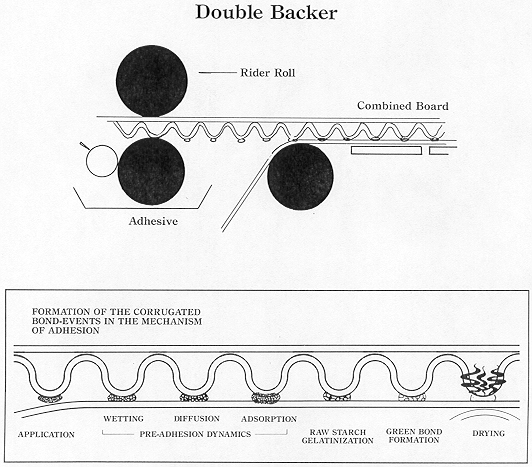
|
Doublebacker
The doublebacker is another matter entirely. There, the time between application
of the adhesive to the flute tip and final green bond formulation may
be hundreds of times greater than at the singlefacer. The doubleback condition
demands the ultimate of the adhesive in terms of water holding ability
and wet tack development. This is why specialty starches invariably allow
higher running speed than do simple corn starch adhesives.
The same properties allow increased running speeds and improved bond quality
at the singlefacer because they can be run wetter and with less total
heat from the machine and the preheaters. In addition, there is evidence
that suggests that less "killing" at the singleface flute
tip exists with specialties than with simple corn starch. |
Troubleshooting Quality and Waste Problems
on the Corrugator
The following pages detail some
of the problems which frequently occur in the process of preparing a starch
formulation and using this adhesive in the formation of corrugated board.
Checklists detail defects and possible actions to be taken.
Problems related to the Corrugating Adhesives are listed in the
first checklist. Typical starch formulation problems are variations
in viscosity, gelatinization temperature, and batch temperature. Solution
of problems of this sort is generally made in the starch preparation area.
Obviously, the starch adhesive should be checked if the situation cannot
be readily improved by machine adjustments. Suppose, for example, that
the singleface glue line shows a poor bond and white appearance at the
cutoff end. A possible cause may be wet paper or a drop in temperature
of one of the corrugator or pressure rolls. The problem could also be
due to the gel temperature being too high, perhaps due to an error in
weighing out the caustic soda.
Problems related to board quality are listed in the second checklist.
These include dry streaks, loose edges, blisters, warp, washboarding,
and others. These problems may be resolved primarily by machine adjustments
such as a preheater wrap, glue application, or web tensions. Nevertheless,
it should be emphasized that although such board problems are usually
resolvable on the singlefacer, doublebacker, or slitter, occasionally
they are attributable to adhesive rather than mechanical reasons. Available
from TAPPI, corrugator companies and suppliers is other corrective action
type information which you may find helpful.
CORRUGATING ADHESIVE PROBLEMS
Viscosity Breakdown
Loss of viscosity of corrugating adhesives can cause serious problems -
scrap, loss of speed, etc. and can be caused by a number of factors such
as:
· excessive water
· shear
· bacteria
· the carrier starch
· temperature rise
Loss of viscosity is important to minimize or prevent because it can lead
to brittle board, low glue application, and a host of other problems.
|
CAUSE
|
SOURCE
|
|
Water
|
- Wash Up Water
|
|
|
- Water jacket at SF
|
|
|
- TVC Coil Leak
|
|
|
- Water Meter Inaccurate
|
|
|
- Excessive Condensate
|
|
1. Viscosity Breakdown - Water
The addition of excessive amounts of water is an obvious cause of loss
of viscosity. Where can this extra water come from? Several sources
are:
Wash up
- the water from wash up at the SF or DB should be sent to
the sewer or to the process water holding tank as some plants are doing.
Water Jacket at SF - leaking into
starch
TVC System - Coils
carrying warm water may have pinhole leaks
Water Meter - loss
of calibration, inaccurate
Condensate - the batch
could contain excessive steam condensate if the steam lines are not
drained first (especially in morning).
|
2. Viscosity Breakdown - Shear (Breakdown)
This type of viscosity loss is caused by intense mechanical action and
friction. Breakdown by this
cause is lessened the better the adhesive is mixed or presheared while
still in the mixing equipment.
Specific causes are:
The agitators in storage tanks (especially if left on continuously).
The supply and return pumps, especially the Viking gear type.
The squeeze through the gap between the metering roll and the
applicator roll.
Friction in the piping, tees, etc. especially if the storage tanks are
located a considerable distance
from the corrugator.
|
|
CAUSE
|
SOURCE
|
|
Shear
|
- Agitation
|
|
|
- Pump and Lines
|
|
|
- Glue Roll/Metering Roll Interface
|
|
|
CAUSE
|
SOURCE
|
|
Bacteria
|
- Dirty Storage Tank
|
|
|
- Dirty Lines
|
|
|
- Water |
|
|
- Air |
|
|
- Inadequate Preservative
|
|
3.Viscosity Breakdown - Bacteria
The cooked carrier starch is attacked by bacteria which convert it into
sugars which dissolve in the water causing
a lowering of viscosity. This can usually be prevented by (1)
periodically cleaning the entire mixing, storage and
circulation system with Trisodium Phosphate (TSP) and chlorine
containing compounds like Clorox or swimming
pool chemicals, and (2) adding preservatives to
domestic corrugating adhesives. Weekend storage requires
additional preservative.
Some common sources of bacteria are: dirty storage tanks and mixers,
dirty circulating lines, the water, air, sweat, etc.
NOTES: 1 - See Cleaning Procedure in Appendix
2 - See "Other Readings" in Appendix
|
4. Viscosity
Breakdown - Carrier
The carrier is the cooked portion of the adhesive and is a major contributor
in determining viscosity~ The type of carrier may influence the viscosity
stability of the adhesive.
Viscosity breakdown or initial low viscosity may be caused by a number
of factors. These include excessive shear and inadequate carrier dry weight.
Excessive temperature in the carrier cooking step may also lead to viscosity
breakdown.
|
CAUSE |
SOURCE |
|
Temperature Rise |
- Singleface |
|
|
- TVC Malfunction |
|
|
- Ambient Temperature |
|
5. Viscosity Breakdown - Temperature Rise
An increase in temperature causes the adhesive to become thinner, much
like motor oil gets thinner as it
becomes warmer. It has been determined that the viscosity changes
approximately 10% if the temperature
changes 2'F (1.0(~C). For instance, if the viscosity measured 40 Stein
Hall seconds at 100OF (38'C), it
would measure about 36 seconds at 1020F (39'C) and 32 seconds at 1040F
(40'C).
There are several sources of heat which would cause a rise in the
temperature after the adhesive is transferred
from the mixer to the storage tank.
The single facer is an obvious source of heat particularly if there is
no water cooled pan. The TVC system can
introduce excessive heat if the hot water temperature is set too high
1.35'F (57Q or higher. The summer heat
is often the culprit. |
- NOTE: The temperature of the TVC water should be below the gel temperature of the adhesive Aim
for 120- 130'F (49-54'C) generally.
CHECKLIST 1 - ADHESIVE
PROBLEMS
Most adhesive is prepared correctly following the recipes and recommendations
of the starch supplier.
At times and for various reasons, the viscosity is too low or too
high at the machine, the gel temperature is too low or too high
and/or the solids may be too high or too low. Some of the reasons are
listed in the following sections.
PROBLEM
1. Viscosity Too Low at Completion of Batch
 |
A. Low Viscosity
If the Adhesive Viscosity is too low the water and dissolved
solids may penetrate too rapidly not leaving enough water to
gelatinize all of the raw starch when the gel temperature is
reached. This could result in poor bonds, etc.
REMEDY
Too much water added - check water measurements.
Not enough starch in carrier.
Agitation period too long in top mixer or after carrier is
dropped in secondary tank.
Carrier portion dropped too slow.
Carrier overheated - follow supplier's recommendations. |
|
2. Viscosity Decrease
in Storage Tank
During Run Period |
Level of tanks allowed
to become too low.
Supply pumps - speed too fast - should be 180-200 R.P.M.
Return pumps - speed too fast - should be 180-200 R.P.M.
Pump motor replaced and speed of new motor too fast.
Circulating lines - long distance between supply tanks and corrugator.
Circulating lines - too many twists and turns (elbows, risers, etc.) in
pipe layout.
Circulating lines - wrong type of valves in line.
Circulating lines - all lines should be pitched so that drainage is toward
the supply tanks.
Lines dirty - bacteria action causing starch breakdown.
Steam leaks at and around single facer, allow condensate to drip in pans
and dilute starch.
Pans washed and cleanup water allowed to return to supply tanks.
Water being accidentally added (water hose) to sump tank of return pump.
Temperature of TVC water may have increased.
TVC System not operating properly. |
|
3. Viscosity Decrease After
Overnight or Weekend Storage |
Bacteria action - not enough
preservative (formaldehyde or equivalent) being added to batch. Add additional
amount for weekend storage.
Cleanup wash water returned to storage tanks instead of sewer.
Agitators and/or circulating pumps allowed to run over the shutdown period.
Circulating lines cleaned out, but allowed to remain full of water - first
starch to machine is no good.
Use of flexo wash up water or process water requires extra preservative. |
B. Viscosity
Increase
This can cause problems ranging from excessive usage of adhesive to wet,
soggy board.
If the Adhesive Viscosity is too high the gel temperature may be
reached before the desired penetration has been achieved resulting in
a poor, "zipper" like bond.
|
PROBLEM
1. Viscosity Too High at Completion of Batch
 |
REMEDY
Incorrect volume of water - not enough.
Batch did not finish to correct volume - Check water measurements and inches
from top.
Too much starch in carrier portion - Do not adjust carrier amount more
than 5 Ibs. (2.3 kg) at a time. Check bag weights or weigh hopper scale.
Temperature of carrier too high [over 1.30'F (54'C) when dropped into secondary.
Caustic swelling may take place.
Carrier portion dropped too fast.
Agitation period not long enough.
Viscosity cup may be dirty giving false viscosity readings.
Steam valve may be leaking causing viscosity rise and "fish- eyes". |
|
2. Viscosity
Increase In Storage Tank
During Run Period |
Agitators in tanks not turned
on.
Temperature of supply tanks low [less than 95'F (350Q - TVC circulating
cold water instead of warm water.
Caustic content too high causing raw starch to swell. |
| 3. Viscosity Increase After Overnight
or Weekend Storage
The illustration at right represents the viscosity which
results in the desired penetration into the paper (cellulose) leaving
enough water behind to gel the raw starch and achieving the desired running
speeds and optimum bond strength. |
A viscosity increase is normal after overnight storage
(8 hrs.) if temperature dropped and there is no agitation.
Viscosity should return to normal with TVC operating, if agitators, circulating
pumps, and TVC turned on at least an hour before corrugator starting time.
Storage temperature and completed batch temperature too high giving caustic
swell.
 |
C. Gel
Temperatures
If the Gel Temperature is too high or too low a number of problems may
be experienced as follows:
|
PROBLEM |
REMEDY |
|
1. Gelatinization Temperature
Too High |
Not enough caustic - increase
1 lb. (0.45 kg) at a time until desired gel temperature is obtained.
New caustic supply - not the same strength as the old supply.
Caustic has been allowed to stand in open, picks up water from air and
does not give correct weight of true caustic.
Incorrect caustic weight - scales not weighing properly, incorrect tare
weight of caustic bucket. Wash and dry bucket as required.
Raw Starch less sensitive to caustic. |
|
2. Gelatinization Temperature
Too Low |
Too much caustic - reduce
no more than 1 lb. (0.45 kg) at a time until desired temperature is obtained.
New caustic supply - received a better grade higher purity.
Starch solids decreased without decreasing caustic.
Incorrect caustic weight - and weighing error causing more than the required
amount of caustic.
Raw starch more sensitive to caustic. |
|
3. Gelatinization Temperature
Varies |
Weight of caustic varies
per batch - something wrong with the weighing system.
Variation in mixing procedure - material weights or water volumes vary
between batches.
Caustic permitted to stand in open air - picks up moisture causing variation
of strength.
Improper procedure used to determine gel temperature.
Caustic added too slow - all caustic should be added within 2 minutes. |
D. Other
Specific Adhesive Conditions Affecting Viscosity and Performance
|
PROBLEM |
REMEDY |
|
1. Temperature Completed
Batch Too Cold |
Water supply too cold -
not heated enough in secondary tank before adding starch. Carrier not
cooked to correct temperature. Batch temperature is regulated by degree
of heating of water in primary mixer or secondary tank before adding starch.
Correct temperature of completed batch - 96-104'F (36-40'C). (See specific
formula sheet). |
|
2. Temperature Completed
Batch Too Hot |
Carrier added too hot [over
125' (52'Q]. Starch slurry in secondary too warm before carrier is added.
Steam leak in line to secondary tank allows temperature to build up. For
high pressure jet cooker systems the water cooler not chilling water for
the starch slurry to the desired low temperature of about 70'F (2PC).
This could cause swelling of the raw starch. Thermometers read incorrectly.
Allow for temperature rise when turning off steam. |
|
3. Carrier Temperature Too
High |
Leaking steam valve - does
not close properly and allows temperature to continue to build up. Too
much water added before cooking carrier - not enough room to add sufficient
cooling water - temperature of carrier after adding cooling water should
be 110-120'F (43-49'C). Cooking temperature permitted to get too high
[1.30-145'F (54-63'C) usual cooking temperature for pearl corn starch],
lower [110-135OF (43-57Q for most Specialty Carriers). Temperature of
supply water varies and at times is too warm. Thermometer on primary tank
reads incorrectly. Action of the thermometer may be slow - allow for temperature
lag. |
|
4. Temperature in Storage
Tanks Too High |
TVC system not operating
properly:
(a) Circulating pump not running
(b) Circulating hot instead of desired water temperature [1.20-130'F (49-54'Q]
(c) Control of circulating pump set too high - also failure of control
to turn on pump.
(d) Agitator not running
(e) Thermostats not operating properly
Starch picks up excessive heat on the corrugator (single facer). Circulating
pipes adjacent to hot steam lines. No water cooling pans. Adhesive mix
being made at temperature above 105OF (40OC). |
|
5. Temperature in Storage
Tanks Too Low |
TVC not
operating properly:
(a) Steam not turned on - circulating cold water instead.
(b) Temperature control does not turn on circulating pump.
(c) No steam or electricity available to TVC system certain hours |
CHECKLIST II - CORRUGATING
EQUIPMENT AND BOARD QUALITY PROBLEMS
|
DEFECTS |
REMEDIES/POSSIBLE CAUSES |
|
Streaks of Heavy Glue
Application - DB Side |
Doctor blade has dirt
under it or it is not adjusted properly. This permits excessive glue to
carry over to the glue roll. |
|
Soft Board |
This defect usually originates
with poor mechanical conditions at the Glue Machine and is normally a
result of excessive glue application. Causes could be floating bearings,
worn bronze bushings at the applicator roll or a high setting. NOTE: See
Appendix "Water Added to Corrugated Board from Corrugated Adhesive |
|
Slipping Bond - DB |
Slipping bond is a result
of a difference in DB liner and SF web speeds with the flutes wiping adhesive
across the liner. Results in a weak bond at the flute tips. Causes are:
(a) Excessive tension on double face liner (b) Loose or worn belts (c)
Belt rollers lifted (d) Top and bottom belts traveling at different speeds
(e) Treatment or finish of bottom liner causing excessive drag on the
hot plates. |
|
Washboard Appearance |
This is more evident
on board with lightweight liners. A combination of heavy glue spread and
overdried liners causes a washboard appearance. NOTE: Less adhesive added
means less washboarding and better print quality and productivity. |
|
"Cracker" Board |
This defect is characterized
by the "snap, crackle and pop" sound obtained when flexing the
combined board plus poor bond on one or both sides of the board. It can
be caused by: (a) Slippage between SF web and double backer liner. (b)
Light glue application. (c) Use of low solids glue. (d) Excessive amount
of unglued or hi-low corrugations. (e) Excessive borax in the formula. |
|
Wide Glue Roll Settings
but Light Glue Application -
DB Side |
Indicator of glue roll
adjustment not reading correctly. Rider roll set too high.
Speed of glue roll too fast - desired speed should be 90- 100 To of paper speed.
SF web may be overdriving the glue roll.
Surface of glue roll so smooth it will not hold film. |
|
Leaning Corrugations |
Misalignment of corrugating
rolls. Excessive wear of corrugating rolls. Loss of compression between
corrugating rolls. Excessive. rider roll pressure at DB glue station. |
| Poor Bond - Center Glue Line of Double-Wall Board

|
Usual problem is not
enough heat to cause starch to gelatinize. Heat from hot plates must transfer
through DB liner, the air space between DB liner and center liner, and
finally the center liner before it reaches the center glue line. This
is too slow so the inner liner needs to be preheated. This liner
carries most of the heat to gelatinize the starch. High solids DB adhesive
helpful. |
|
Increase in Glue Consumption
With No Apparent Excess on Board |
Packing on pumps leaking
- check supply or return pump.
Valve leaking-check valves in cleanout line going to sewer.
Incorrect tank volumes being reported.
Glue pans overflowing-outlet may be clogged. |
|
Glue Line - White Appearance
(Incomplete Starch Gelation) |
Gel temperature too high.
Materials have wet streaks - too much moisture.
Pressure roll, corrugator rolls or hot plates not at correct temperature.
Roll temperature low because of low ' steam pressure or condensate removal
is poor.
Medium so absorbent and/or viscosity so thin there is insufficient water
to gel all raw starch. |
|
Spotty Adhesion Every
Other Flute - SF |
Glue roll motor burned
out - paper driving roll. Finger setting - too low, flutes hit glue roll
and bounce. |
|
Spotty Glue Application
SF Side |
Starch accumulating on
side of fingers and wiping glue roll. Fingers set too high - holds medium
away from glue roll. Glue roll set too low from corrugator roll.
Wet corrugating medium tends to stick to corrugator rolls and not fluff
out. The preconditioner or steamer dripping water on medium. Dirty forming
rolls - oil mist not working. |
|
Light Glue Pattern SF
- Slow Speed |
Adhesive - light viscosity
- film flows off adhesive roll. Glue roll too far from corrugator roll,
medium hangs up in corrugator roll and does not fluff out. Glue roll taper
speed set too low. |
|
Light Glue pattern DB
- Slow Speed |
Adhesive - light viscosity
- film breaks and flows off roll reducing pickup, also adhesive has more
time to soak into medium.
Glue roll too slick with high polish or chrome. |
|
Dry Streaks (Area Between
Fingers) - SF Side |
Dirt (paper dust, gelled
starch, etc.) wipes glue roll causing dry streak on sheet. |
|
Dry Streak at Fingers
SF Side |
Fingers set too high
- holding medium away from adhesive roll. Fingers not clean - starch set
up on fingers, wiping adhesive off glue roll. Fingers worn or bent, or
not centered in grooves of adhesive rolls.
Cleanout prongs - dirty or improperly set.
Starch adhesive - viscosity too' high - cannot flow around fingers. Grooves
in adhesive roll too wide due to wear. |
|
Dry Streak Along Finger
Line of DB Side |
Indentation caused by
medium forced into grooves of bottom corrugator roll. Unless excessive
glue is used, indentation does not pick up glue and a dry streak results.
Caused by too much tension on medium, wide grooves in small corrugator
roll due to wear, wear on top corrugator roll caused by failure to use
lateral adjustment.
Large corrugator roll dirty. |
|
Adhesive Set Up In SF
Glue Pan |
Starch gel temperature
too low.
Starch not circulating properly in the glue pan.
"Dead Spots" in corners or back of pan where there is no movement
of starch.
Supply inlets may be clogged or at the wrong location.
Supply valve not opened enough to allow good pan circulation.
If supply valve is cut down because the overflow will not take the excess,
then the overflow is too small or partially clogged.
Starch supplied to corrugator too hot - 105'F (41'C) plus.
Water may not be circulating in water cooled pan. |
|
Adhesive Sets Up on Fingers - Need Frequent Cleaning
 |
Gel temperature of starch
too low or temperature of starch too high.
Fingers worn - too much starch allowed to flow past finger. Grooves in
adhesive roll too wide.
Clean out rings or fingers permit too much starch to flow around fingers.
Clean out fingers set too tight against glue roll.
Taper speed set above 96% of paper speed.
Water to water cooled pan turned off. |
|
Loose Edge - SF Side |
Finger located at edge
of sheet - too low causing flutter, or rubbing edges of medium deforming
f lutes.
Dirt wiping glue roll at edge.
Dirt on edge of pressure roll and bottom glue roll.
Not enough pressure on pressure roll.
Wet edge on liner, also liner or medium may have low caliper edge.
Medium wider than liner allowing glue to build upon pressure roll.
Slitter knife set improperly. |
|
Loose Edge - DB Side |
Sheet guide at end of
bridge mashing flutes.
Wet streak on edge of liner.
Worn belts or belt rollers may be raised or missing.
Dirt on hot plates.
Adhesive solids too low.
Too much heat for the speed being run.
Slitter knife set improperly. |
|
Shallow Glue Bond - SF
or DB Side |
Adhesive - low solids
in formula.
Preheating too much and over-drying liner.
Too much borax in formula - not enough penetration.
Taper speed drive - not operating properly at high speeds.
Paper hard to wet/penetrate. Consider adhesive adjustment/reformulation
or wetting agent. |
|
High and Low - Flutes
Not Glued - SF Side |
Fingers set too low,
also may be worn or broken.
Not enough pressure between corrugating rolls.
Dirty corrugating rolls.
Corrugating medium - can be too wet or too dry, medium roll may be out
of round. tension may not be adjusted correctly.
Uneven pressure on pressure roll.
Glue roll not at correct angle to the forming roll. |
|
Blisters (Area Of No Adhesion) - SF |
Blisters in direction
of board travel - fingers if not worn may be adjusted too close or too
tight, tension of medium roll too tight, dirt particles in nip of glue
roll and doctor roll.
Blisters across direction of board travel - one or more fingers set too
far from corrugator roll (medium flutters), uneven tension on medium or
out of round medium roll.
Diagonal blisters across liner - variable or uneven tension of liner roll. |
|
Flutes Not Glued - DB |
Hi-Low corrugations formed
at single facer.
Rider roll set too high - SF web not held in contact with adhesive film.
Too many belt rollers raised or removed.
Belt or belt rollers not holding SF web in uniform contact with liner.
Not enough tension on single face web going to glue station. |
|
Splashing of Adhesive
in Flutes - DB |
Rider roll set too low
on SF web.
Glue film too heavy on adhesive roll.
SF web wrapping glue roll too much.
Ratio of taper speed drive set too low.
Doctor blade not cleaning metering roll.
Adhesive not properly formulated and producing rings.
Glue roll overriding the slip clutch. |
|
Spray or Splashing of
Adhesive Off Corrugating Rolls |
Glue roll set too close
to corrugator roll.
Glue adjustment - too heavy a film on glue roll.
Anything that causes a heavy bead of glue to form on glue roll and transfer
to the corrugator roll - dirt on side of fingers, dirt in nip of glue
roll. |
|
Foaming of Adhesive in
Pans or Storage Tanks |
Add a small amount of
defoamer - [approx. 1/24 pint/ 700 gallon batch (0.2-0.5 liters/2,650 liter batch)]
or as recommended by starch supplier. |
CHECKLIST 111 - WARP
CONTROL
What causes it?
Usually moisture imbalance between liners or tension imbalance
-
Types of Warp:
|
CAUSE |
REMEDY |
Upward (Normal)
Warp
SF Side Too Wet/DB Side Too Dry
Paper

Adhesive |
Increase SF liner wrap.
Reduce DB liner wrap.
Increase speed if possible.
Increase bridge content.
Reduce, not turn off, SF shower.
Increase SF web wrap.
Reduce SF adhesive setting.
Increase DB adhesive setting (last resort). |
|
Downward
(Reverse) Warp
DB Side Too Wet/SF Side Too Dry
Paper

Adhesive |
Increase DB liner wrap.
Decrease SF liner wrap.
Decrease speed if possible.
Reduce bridge content.
Reduce SF web wrap.
Increase shower.
Reduce DB adhesive setting
Increase SF adhesive setting (last resort). |
|
S
- Warp |
Often caused by roll
having wet edge or streak in machine direction. Steam leak in one of hot
plates. |
|
Diagonal
or Twisted Warp |
Uneven moisture condition.
Misalignment of rolls. Cross tension due to uneven draw in the belts |
| End-To-End (Lengthwise)
Warp
Down
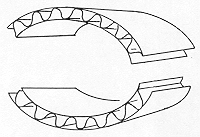
UP |
Reduce DB liner brake.
Increase SF web tension.
Increase DB liner brake.
Reduce SF web tension. |
Economics
Potential
Benefits from Use of Specialty Carrier Starches.
BENEFITS:
1. Increased speed
2. Decreased wet edge
3. Increased mileage
4. Better warp control
5. Decreased washboarding
6. Reduced waste
7. Reduced Customer Returns
Profit
Increased speeds plus improved quality of boxes means INCREASED PROFITS.
What will an improved adhesive cost?
The following examples will help answer that question.
Price vs. Cost - Batch, Application Cost
The first example (A) shows how the Price of a Batch is determined.
Then is shown how Cost per Dry Pound (kilo
grams) of adhesive is calculated. With that information the Application
Cost can be determined.
Application levels (pounds per 1000 square feet or MSF) are determined
several ways - usually either from a month
long accounting period or by Tank Drop consumption checks (See Appendix),
Relative Cost Values - Paper, Production, Adhesive
The next example (B) shows not only the Relative Cost Values of Paper,
Production and the Adhesive but how the numbers are calculated.
"Speed is Profit" - Specialty Starches
The final example (C) shows that Speed is Profit. It also shows that the
productivity gains from using a specialty carrier starch can be realized
at potentially no increased cost.
A. Price vs. Cost Example - Pearl Corn Starch
Typical Domestic Formulation - Single Viscosity
Batch Price
Price of Batch Materials
Carrier Starch 200 lb. @ $10/cwt. = $ 20.00
Raw Starch 1100 lb. @ 10/cwt. = 110.00
Caustic Soda 32 lb. @ 35/cwt. = 11.20
Borax (5 mol) 24 lb. @ 21/cwt. = 5.04
Preservative 1 lb. @ 50C/Ib. = 0.50
1357 lb. =$146.74/Batch
146.74
Cost per Dry Pound = - = 10.8(2b.
1357
Application Cost
Adhesive Application Cost = 011b. x Application Level
10.8C/Ib. x 2.0 lb./MSF = 21.6c/MSF
10.80/1b. x 2.5 lb./MSF = 27c/MSF
10.8C/Ib. x 3.0 lb./MSF = 32.4c/MSF
10.8C/Ib. x 3.5 lb./MSF = 37.8C/MSF
10.80/1b. x 4.0 lb./MSF = 43.2C/MSF
- NOTE: The prices
for the starch, caustic soda (sodium hydroxide), borax, and preservative,
are approximate.
Value Engineering
B. Relative Values of Paper Production and Starch
Sample Calculation.
Assume paper cost = $400/ton
If 600 lb. test doublewall weighs 350 lb./MSF cost for 600 lb. test doublewall
= $70.00/MSF
If paper is W' width and corrugator speed is 200 FPM, production cost based
on the machine burden at $500/hr. is $6.95/MSE
Suppose we are running nonwaterproof doublewall with an average starch
application of 5 Ibs./MSF. If we use a hypothetical starch which costs
about 10c/1b., our starch application cost is 50c/MSE
Therefore,
% of Total
Paper cost = $70.00/MSF 90.4
Production cost = 6.95/MSF 9.0
Starch cost .50/MSF 0.6
Total = $77.45/MSF 100%
Starch cost is only 0.6% (less than 1%) of total board cost.
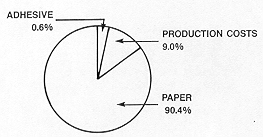
C. "Speed is Profit" - Specialty Starch
Sample Calculation
Boxplant in Anytown, U.S.A. is running 3 shifts per day five days per week.
An average of 10,800,000 sq. ft. of board is produced per week.
Average machine speed = 250 FPM
paper width = 72 11
machine burden = $500.00/hr.
From Machine Burden Chart $500/hour, production cost is $5.55/MSF. If starch
used to achieve 250 FPM on singlewall costs 11c/1b. and is applied at
2.5 lb./MSF, starch application cost is about 280/MSE Paper cost is fixed.
Therefore,
Production cost = $5.55/MSF
Starch cost
.28/MSF
Total (excluding paper cost) = $5.83/MSF
Suppose a specialty carrier starch is used and we can increase corrugator
running speed to 275 FPM, an increase of 25 FPM.
Our average square footage of board produced increased
from 90,000 sq. ft.lhr. to 99,000 sq. ft.lhr.
Production cost drops (see Machine Burden Chart) from
$5.55/MSF to $5.05/MSF
Old production cost = $5.55/MSF
New production cost = 5.05/MSF
Net savings
= $0.50/MSF
Therefore, new starch used can cost 78c/MSF (old starch
cost of 280/MSF plus savings of 50c/MSF) or up to 21c/1b. and we still
break even!
Also, we have increased our board
production by 9,000 sq. ft./hr., and, consequently, freed the corrugator
for an additional 10 hours available production
time at no extra cost.
- NOTE:
The savings would be even greater for wider paper.
Quality is Profit
The use of specialty adhesives has been shown to result in faster running
speeds and improved quality. Better bonds lead to reduced scrap which
normally results in increased profits. A 1% reduction in scrap can save
some plants $10,000/month and the impact of good quality and reduced returns
from a customer can be even greater.
SPC (Statistical Process Control)
The use of control charts to plot data of batches and adhesive from the
machine, e.g. viscosity, temperature, gel temperature, etc. is growing.
This should lead to reduced variation in adhesive and other variables
and faster correction of problems.
Machine Burden @ $500 Per Hour
In Terms of Cost Per Thousand Square Feet of Combined Board
Paper Width
-Speed 54 It 60 pp
6611 72 p' 7811 84 'p 90 It 9611 102 '1
100 fpm 18.55 16.70 15.15 13.90 12.80 11.90 11.10 10.42 9.80
125 fpm 14.85 13.35 12.10 11.20 10.25 9.50 8.95 8.33 7.83
150 fpm 12.35 11.10 10.10 9.25 8.55 7.95 7.60 6.95 6.53
175 fpm 10.55 9.50 8.65 7.95 7.30 6.80 6.40 5.95 5.60
200 fpm 9.25 8.35 7.60 6.95 6.40 5.95 5.55 5.22 4.90
225 fpm 8.25 7.40 6.75 6.15 5.70 5.30 4.90 4.63 4.35
250 fpm 7.40 6.65 6.05 5.55 5.15 4.75 4.35 4.17 3.93
275 fpm 6.75 6.05 5.50 5.05 4.65 4.35 3.95 3.78 3.57
300 fpm 6.25 5.55 5.05 4.65 4.25 3.95 3.60 3.47 3.27
325 fpm 5.70 5.15 4.65 4.25 3.95 3.65 3.45 3.20 3.02
350 fpm 5.30 4.75 4.35 3.95 3.65 3.40 3.20 2.98 2.80
375 fpm 4.95 4.45 4.05 3.70 3.45 3.15 2.95 2.78 2.62
400 fpm 4.60 4.15 3.80 3.45 3.20 3.00 2.80 2.60 2.45
425 fpm 4.35 3.95 3.55 3.25 3.00 2.80 2.60 2.45 2.30
450 fpm 4.10 3.70 3.35 3.10 2.80 2.65 2.45 2.32 2.18
475 fpm 3.90 3.50 3.20 2.90 2.70 2.50 2.30 2.20 2.07
500 fpm 3.70 3.35 3.05 2.80 2.55 2.40 2.20 2.08 1.97
525 fpm 3.55 3.20 2.90 2.65 2.45 2.25 2.15 1.98 1.87
550 fpm 3.35 3.05 2.75 2.55 2.35 2.15 2.05 1.90 1.78
575 fpm 3.25 2.90 2.65 2.40 2.25 2.05 1.95 1.82 1.70
600 fpm 3.10 2.80 2.55 2.30 2.15 2.00 1.85 1.73 1.63
625 fpm 2.95 2.65 2.40 2.20 2.05 1.90 1.80 1.67 1.57
650 fpm 2.85 2.55 2.35 2.15 2.00 1.85 1.70 1.60 1.50
700 fpm 2.65 2.38 2.17 1.98 1.83 1.70 1.58 1.48 1.40
800 fpm 2.31 2.08 1.89 134 1.60 1.49 1.39 1.30 1.23
900 fpm 2.06 1.85 1.68 1.54 1.42 1.32 1.23 1.16 1.09
1000 fpm 1.85 1.67 1.52 1.39 1.28 1.19 1.11 1.04 0.98
Sample Computation
A) Assume speed of 350 fpm and 78" (6.5 ft.) paper width
B) Production per minute - (350 ft.lmin.) x (6.5 ft.) = 2275 sq.ft. = 2.275
MSF
C) Production per hour - (2.275 MSF/min.) x (60 min./hour) = 136.5 MSF
D) Production cost - ($500.00/hour) + (136.5 MSF/hour) = $3.65/MSF